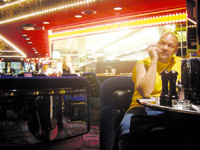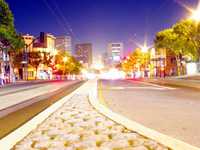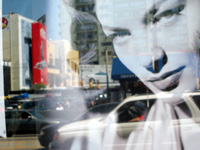
Five UT students follow in Robert Frank's footsteps to photograph our country in the 21st century
by Paige M. Travis
The archetype of the epic journey, the hero's odyssey from ignorance to understanding, might find its modern representation in the cross-country road trip. Leaving home is an invitation to the unexpected, a conscious decision to find out what and who exists outside the boundaries of your little world, a means of self-discovery by experiencing the unknown. Whether you relate to Jack Kerouac's On the Road or Tom Green's Road Trip, the open road has a timeless allure. And the desire to document it is equally irresistible.

Photographer Robert Frank set out in 1955 to document America, financed by a fellowship from the Guggenheim. Born in Zurich in 1924, he was greatly influenced by his mentor Walker Evans' candid portraits of Depression-era Americans. Over the span of two years, Frank covered thousands of miles across the country's landscape, capturing faces and images of a post-war nation, a multi-racial population living with conflict and change. In his introduction to Frank's published compilation of the project, The Americans, Jack Kerouac wrote that the photographer "sucked a sad, sweet poem out of America."
Inspired by Frank's intimate and insightful portrait of our country, five art students at UT wanted to find out how Frank's America has changed in the past 50 years and how it might have stayed the same. They pitched their idea and received a $2,000 grant from the Dorothy Dille Endowment. Instead of spending two years bouncing from coast to coast, they took two weeks.
"We felt strongly about being Americans and loving America," says Rob Travis (no relation to this writer). "But we didn't like the direction we saw it going." The expressions of patriotism inspired by the terrorists attacks of Sept. 11, 2001 and the war on Iraq left the students wondering, "What's it all about?" and feeling "that this whole rebirth of patriotism was kind of false... [designed] to sell more flag stickers."

Travis and four other undergrads in the Media Arts department — Andrew Witt, Banner Gwin, Jesse Swanson and Caleb Wilson — packed two cars with necessities, including 11 cameras — three digital, one medium format, one large format, two video cameras and four 35mm. The trip began in Chattanooga on July 4, 2003.
While the group didn't follow in Frank's exact path, they hit some major landmarks: New Orleans, San Antonio, the Grand Canyon, Las Vegas, Los Angeles, and their destination of San Francisco.
"We covered 14 states in 16 days," Travis says. "We were constantly moving." They would pull into campsites at 4 a.m. and start the trip all over again at 8 a.m. Travis still sounds amazed that under such cramped, meager and exhausting conditions, the men didn't resort to homicide.
"I totally thought that being trapped in a car with three or four other guys, we would end up hating each other," he says, adding that he's traveled with smaller groups for fewer days with disastrous results.

In typical road trip fashion, not everything went according to plan. The crew was left with one car when Swanson took the other vehicle to drive to see his ill grandfather. And they got pulled over by a Texas State Trooper for driving in the left lane. The incident, for which they were given a warning, was considerably less dramatic than Frank's own run in with the law. During the height of McCarthyism and rampant paranoia of foreigners, the Swiss-born photographer was arrested in Arizona and jailed for three days before authorities confirmed that he wasn't a Russian spy. As the 21st century team approached Las Vegas at dawn, their mostly trustworthy Ford Taurus broke down on the border of Nevada. And lest you think artists aren't skilled in such things, the group fixed the car themselves (and documented the triumph with a photo posted on their website).
The team established a rule at the first of the trip: if one person saw a photo opportunity, they'd pull over, no questions asked. "If anyone wants to take a picture, the pictures come first," Travis says. "Nobody can ever say anything about somebody taking too long. That's what the trip is about, not the destination. It's about taking photos. Nobody ever complained. We just did it."
With several cameras wielded by guys from different artistic backgrounds and aesthetic impulses, the results were diverse and yet inspired by a common drive.
"There were a lot of times we would all take pictures of the same kind of thing. The same location, same people. But it was amazing how different the photographs were." One person would notice something in a block of Hollywood Boulevard that no one else noticed. After a few days of reviewing the pictures, some common themes arose.
"We were feeding off each other's creative energy. We're very different photographers with different backgrounds. But we all kinda tuned into this same mindset."
When it came time to weed the 4,000-plus pictures to 25-35 shots for display at a Sept. 12 reception/exhibit at Gallery 1010, the photographers shared ownership in the collection. "We always said we're not going to put the names on the photos," Travis says. "We are one. We all took the pictures. It doesn't matter who fired the shutter. It was us, it was the trip."
Now that the best photos have been displayed for an enthusiastic crowd that swarmed the Candy Factory studio on a Friday night, the men will pursue having the collection published as a book. "I think we can," Travis says. "It's gonna take finding the right publisher who's willing to get the project together."

Travis also hopes to find a larger gallery to exhibit more of the photos, perhaps a space on Gay Street recently used for an exhibit organized by Yee-Haw Industries. In the meantime, you can vicariously experience the roadtrip of a lifetime at the American Photography Project. Most of the photos are artistic, some stray into goofy souvenir document territory, but they all reveal moments that inspired the artists. From abstracts to portraits to landscapes, the photographs reflect the different colors of 21st century America, the variety of faces and personalities. Some photos imply and beg for stories—the heavyset, brown-skinned woman sitting against a tan adobe wall, left hand grasping a plastic fast food cup, right hand covering her eyes—and others explain themselves thoroughly—a grainy picture of the Grand Canyon whose variation of color suggests the Smokies at the peak of autumn. (Travis says the photo was taken at 2 a.m. with a 15-second exposure, the light of the moon revealing the details of the sprawling expanse of the national treasure.)
The photographs are a travelogue and a scrapbook, a reminder of your own travels or places and people you haven't seen yet—like the Hamburger Hamlet in Los Angeles—and a strong testament to the power of the road trip, a vehicle for finding out what's really going on in our country.

September 18, 2003 * Vol. 13, No. 38
© 2003 Metro Pulse
| 




